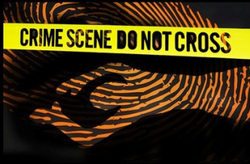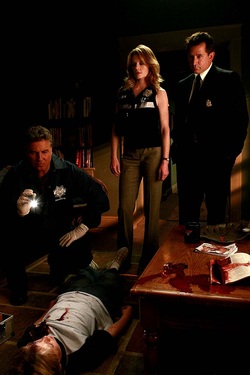A crime scene is a location where an illegal act took place, and comprises the area from which most of the physical evidence is retrieved by trained law enforcement personnel, crime scene investigators (CSIs) or in rare circumstances, forensic scientists.
There are two kinds of evidence at a crime scene
Physical Evidence at a Crime Scene Evidence used to resolve an issue can be split into 2 areas. Testimonial evidence and physical evidence. The testimonial evidence would be any witnessed accounts of an incident. The physical evidence would refer to any material items that would be present on the crime scene. These items would be presented in an issue or incident to prove or disprove the facts of the issue. What will evidence collected at a scene do for the investigation :
Types of Evidence
Who's at the Scene?
Police officers are typically the first to arrive at a crime scene. They arrest the perpetrator is he's still there and call for an ambulance if necessary. They are responsible for securing the scene so no evidence is destroyed.
The CSI unit documents the crime scene in detail and collects any physical evidence.
The district attorney is often at a crime scene to help determine if the investigators need any search warrants to proceed and obtain those warrants from a judge.
The medical examiner (if a homicide) may or may not be there to determine a preliminary cause of death.
Specialists (entomologists, forensic scientists, forensic psychologists) may be called in if the evidence requires expert analysis.
Detectives interview witnesses and consult with the CSI unit. They investigate the crime by following leads provided by witnesses and physical evidence.
Physical Evidence at a Crime Scene Evidence used to resolve an issue can be split into 2 areas. Testimonial evidence and physical evidence. The testimonial evidence would be any witnessed accounts of an incident. The physical evidence would refer to any material items that would be present on the crime scene. These items would be presented in an issue or incident to prove or disprove the facts of the issue. What will evidence collected at a scene do for the investigation :
- May prove that a crime has been committed.
- Establish any key elements of a crime.
- Link a suspect with a scene or a victim.
- Establish the identity of a victim or suspect.
- Confirm verbal witness testimony.
- Exonerate the innocent.
Types of Evidence
- Impressions include fingerprints, tool marks, footwear, fabric impressions, tire marks and bite marks.
- Forensic Biology includes blood, semen, body fluids, hair, nail scrapings, blood stain patterns,
- Trace Evidence includes gun shot residues, paint, glass and fibers.
- Firearms includes weapons, gun powder patterns, casings, projectiles, fragments, pellets, wadding and cartridges.
- Question Documents
Who's at the Scene?
Police officers are typically the first to arrive at a crime scene. They arrest the perpetrator is he's still there and call for an ambulance if necessary. They are responsible for securing the scene so no evidence is destroyed.
The CSI unit documents the crime scene in detail and collects any physical evidence.
The district attorney is often at a crime scene to help determine if the investigators need any search warrants to proceed and obtain those warrants from a judge.
The medical examiner (if a homicide) may or may not be there to determine a preliminary cause of death.
Specialists (entomologists, forensic scientists, forensic psychologists) may be called in if the evidence requires expert analysis.
Detectives interview witnesses and consult with the CSI unit. They investigate the crime by following leads provided by witnesses and physical evidence.
Page by Paige Oursler


